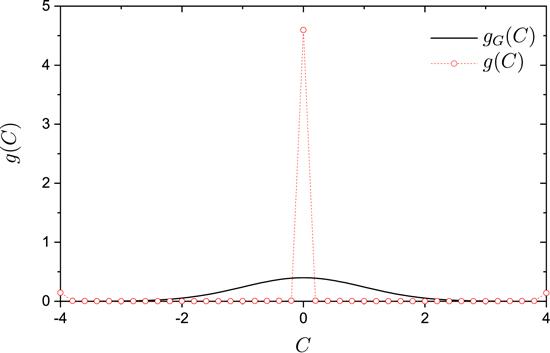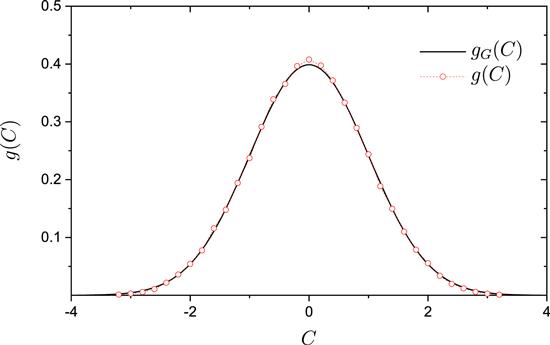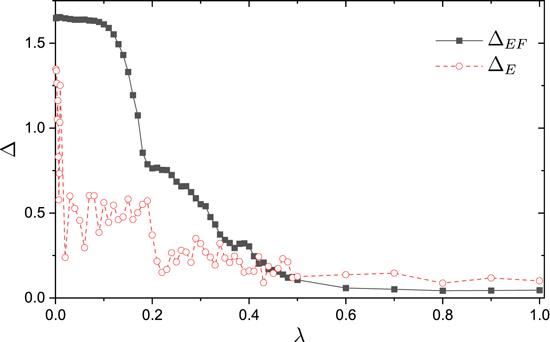 ,1,21Department of Modern Physics,
,1,21Department of Modern Physics, 2CAS Key Laboratory of Microscale Magnetic Resonance,
Received:2020-10-16Revised:2020-10-29Accepted:2020-11-4Online:2021-01-07

Abstract
Keywords:
PDF (822KB)MetadataMetricsRelated articlesExportEndNote|Ris|BibtexFavorite
Cite this article
Zao Xu, Yin-Chenguang Lyu, Jiaozi Wang, Wen-Ge Wang. Sensitivity of energy eigenstates to perturbation in quantum integrable and chaotic systems. Communications in Theoretical Physics, 2021, 73(1): 015104- doi:10.1088/1572-9494/abc7b0
Introduction
Quantum manifestation of classical chaos is an important topic, which has been studied for several decades [1, 2]. Although manifestations in the spectral statistics have been studied well [3–7], not so much is known about wave functions, e.g. about statistical properties of energy eigenfunctions (EFs). In this paper, a new method is proposed and is shown capable of revealing interesting features of EFs of quantum chaotic systems.Classical chaos refers to sensitivity of motion to initial condition; in Hamiltonian systems, this is equivalent to sensitivity to perturbation. Quantum mechanically, due to the unitarity of Schrödinger evolution, quantum motion can not be sensitive to initial condition, while, it exhibits certain type of sensitivity to perturbation, measured by the so-called quantum Loschmidt echo (LE), or Peres fidelity [8]. Loosely speaking, the LE decays exponentially in quantum chaotic systems under perturbations neither very weak nor very strong (see, e.g. [9, 10]); here, under relatively strong perturbations, the decay rate is given by a Lyapunov-exponent-type quantity of the underlying classical dynamics [9]. In contrast, in integrable systems, the LE shows a Gaussian decay within some initial times [11], followed by a power-law decay at long times [12].
One interesting question is whether stationary properties of quantum systems, particularly of their EFs, may exhibit some notable difference between integrable and chaotic systems under small perturbations. Intuitively, one may expect a positive answer. In fact, according to the semiclassical theory, the zeroth-order contribution to an EF from the phase-space motion is given by a uniform distribution in the classical energy surface for a chaotic system, meanwhile, in an integrable system, an EF resides around some tori [2, 13, 14]. These two geometric structures in the phase space usually behave differently under small perturbations.
To find out a quantity that may measure the sensitivity of chaotic EFs to perturbation, one may start from the so-called Berry’s conjecture for EFs of quantum chaotic systems in the configuration space [13]. Basically, the conjecture states that components of EFs in classically-energetically-allowed regions may be regarded as certain Gaussian random numbers. (Specific properties of the underlying classical dynamics may induce certain modifications to the conjecture [15–22].) Since components of integrable systems can not be regarded as Gaussian random numbers, it is natural to expect a notable difference between statistical properties of EFs in integrable and chaotic systems in the configuration space [23].
Berry’s conjecture is not written in a form that can be immediately used in the study of influence of small perturbation to statistical properties of EFs in unperturbed basis. To do this, one needs to consider components of EFs in classically-energetically-allowed regions of an integrable basis, which are rescaled by the averaged shape of the EFs, with the care of not taking average over the integrable basis states [24]; in quantum chaotic systems, this rescaling procedure leads to a Gaussian shape of the distribution of EF components. In this paper, we show that, under small perturbations, the distribution of rescaled components of perturbed EFs on unperturbed bases exhibit qualitatively different features in integrable and chaotic systems.
Analytical analysis
We use H0 to denote the Hamiltonian of an unperturbed system. Its eigenstates are indicated by ∣k⟩, with eigenenergies ${E}_{k}^{0}$ in the increasing energy order,Components of the EFs of the perturbed states on the unperturbed basis are written as
In most physical models of realistic interest, there exist certain dynamic Lie groups behind them, such that observables of realistic interest are written as simple (at least not complicated) and regular functions of generators of the groups. In this paper, we study the distribution of rescaled components ${\widetilde{C}}_{\alpha k}$ under small perturbations of this type, to see whether it may supply information useful for the purpose of distinguishing between quantum chaotic and integrable systems.
To achieve this goal, let us consider the first-order perturbation expansion of an arbitrary perturbed state ∣α⟩. Using kα to indicate the label k for which ${E}_{k}^{0}$ is the closest to Eα, under sufficiently weak perturbation, one writes
To analyze properties of the elements ${V}_{{{kk}}_{\alpha }}$, one may employ a basis, written as ∣n⟩, which is given by states that are expressed as simple functions of generators of the underlying dynamic group. One may always find out an integrable Hamiltonian, denoted by Hint, which is a simple function of the generators and whose eigenstates are just the states ∣n⟩. (For example, in some cases, Hint may be the particle-number operators.) Generically, one writes
Let us first discuss an integrable Hamiltonian H0. In the case that H0 is given by Hint with λ=0, the states ∣k⟩ are identical to the states ∣n⟩. Since the operator V is a simple function of the above-discussed generators, by which the states ∣n⟩ are constructed, the matrix elements ${V}_{{{kk}}_{\alpha }}$, which are given by Vmn=⟨m∣V∣n⟩, are regular functions of the labels m and n. In fact, in most realistic models, these elements vanish for most pairs (m, n) in a Hilbert space not small. Then, from equation (
In the case that H0 is integrable but not identical to Hint, if the components ⟨n∣k⟩ are not quite complicated functions of the label n, it is straightforward to generalize discussions given above. One still reaches the conclusion of notable deviation of the distribution of ${\widetilde{C}}_{\alpha k}$ from the Gaussian distribution.
Next, we discuss a generic quantum chaotic system H0. As shown in [24], those components Dkn of ∣n⟩ whose corresponding tori lie in classically-energetically-allowed regions can be written in the following form
Usually, main bodies of the EFs of ∣k⟩ on the basis of ∣n⟩ lie in the corresponding classically-energetically-allowed regions. This implies that the expression in equation (
Numerical simulations
For the purpose of numerically testing the analytical predictions given above, we have employed a three-orbital Lipkin–Meshkov–Glick model [25]. This model is composed of Ω particles, occupying three energy levels labeled by r=0, 1, 2, each with Ω-degeneracy. Here, we are interested in the collective motion of this model, for which the dimension of the Hilbert space is $\tfrac{1}{2}({\rm{\Omega }}+1)({\rm{\Omega }}+2)$. We use ηr to denote the energy of the rth level and, for brevity, set η0=0. The Hamiltonian H0 in equation (In our numerical simulations, we set V=U. Parameters fixed in our simulations are μ1=0.0032, μ2=0.0036, μ3=0.0039, μ4=0.0048, ϵ=10−6, and ε=10−3. The particle number is set at Ω=140, for which the dimension of the Hilbert space is dH=10011. The width δe is adjusted, such that each window Γα includes 12 levels. In the computation of the distribution of components for a given pair of perturbed and unperturbed Hamiltonians, 400 perturbed states ∣α⟩ that lie in the middle energy region were used and, for each state ∣α⟩, 400 components ${\widetilde{C}}_{\alpha k}$ of ∣k⟩ in the middle energy region were used.
Let us first discuss the integrable case with λ=0 for H0. We took η1=0.3532 and η2=0.5714, for which the winding number is close to the golden mean $\tfrac{\sqrt{5}-1}{2}$. The distribution g(C) was found quite different from the Gaussian form, with a high peak in the middle region (figure 1), in agreement with the analytical predictions discussed above.
Figure 1.
 New window|Download| PPT slide
New window|Download| PPT slideFigure 1.The distribution g(C) of rescaled EF components ${\widetilde{C}}_{\alpha k}$ (circles connected with dotted line), for an integrable Hamiltonian H0 with λ=0, ε=0.001, η1=0.3532, and η2=0.5714. The solid curve indicates the Gaussian distribution gG(C) in equation (
Next, we discuss quantum chaotic systems H0, whose nearest-level-spacing distribution is close to that predicted by the random matrix theory. In agreement with the analytical predictions, we found that the distribution g(C) is quite close to the Gaussian form. One example is given in figure 2 with λ=0.8.
Figure 2.
 New window|Download| PPT slide
New window|Download| PPT slideFigure 2.Similar to figure
We have further studied the process of transition of H0 from integrable to chaotic. To be quantitative, we have computed the difference between the distribution of rescaled components ${\widetilde{C}}_{\alpha k}$ and the Gaussian distribution, denoted by ΔEF
Figure 3.
 New window|Download| PPT slide
New window|Download| PPT slideFigure 3.Variation of the deviation ΔEF (solid squares connected by solid line) and ΔE (open circles connected by dashed line) with the parameter λ.
Summary
In this paper, a method is proposed and used to show qualitative difference between EFs of integrable and chaotic quantum systems. The method is based on difference in the response of EFs to small perturbations. That is, for quantum chaotic systems, the response shows a random feature such that the distribution of rescaled components of the perturbed system is close to a Gaussian form. While, for quantum integrable systems, the distribution is far from the Gaussian form. This difference in the response is useful in the study of integrability-chaos transition of quantum systems and may be used as an indicator of quantum chaos.Acknowledgments
This paper was supported by the National Natural Science Foundation of China under Grant Nos. 11535011 and 11775210.Reference By original order
By published year
By cited within times
By Impact factor
DOI:10.1103/PhysRevE.48.R1613 [Cited within: 1]
[Cited within: 2]
DOI:10.1007/BF02798790 [Cited within: 1]
DOI:10.1103/PhysRevLett.52.1
DOI:10.1098/rspa.1985.0078
DOI:10.1238/Physica.Topical.090a00128
DOI:10.1238/Physica.Topical.090a00128
DOI:10.1088/0305-4470/37/3/L02 [Cited within: 1]
DOI:10.1088/0305-4470/37/3/L02 [Cited within: 1]
DOI:10.1103/PhysRevA.30.1610 [Cited within: 1]
DOI:10.1103/PhysRevE.71.066203 [Cited within: 2]
DOI:10.1016/j.physrep.2006.09.003 [Cited within: 1]
DOI:10.1088/0305-4470/35/6/309 [Cited within: 1]
DOI:10.1103/PhysRevE.75.016201 [Cited within: 1]
DOI:10.1088/0305-4470/10/12/016 [Cited within: 2]
DOI:10.1088/0305-4470/10/12/016 [Cited within: 2]
[Cited within: 1]
[Cited within: 1]
DOI:10.1103/PhysRevLett.53.1515 [Cited within: 1]
DOI:10.1103/PhysRevLett.58.1296
DOI:10.1103/PhysRevE.54.954
DOI:10.1103/PhysRevE.57.7313
DOI:10.1103/PhysRevE.63.066214
DOI:10.1088/0305-4470/35/3/307
DOI:10.1088/0305-4470/36/38/102
DOI:10.1088/0305-4470/36/38/102
DOI:10.1088/0305-4470/36/38/102
DOI:10.1103/PhysRevE.71.056212 [Cited within: 1]
[Cited within: 1]
DOI:10.1103/PhysRevE.97.062219 [Cited within: 3]
DOI:10.1016/0029-5582(65)90862-X [Cited within: 1]
DOI:10.1103/PhysRevE.57.323 [Cited within: 1]
